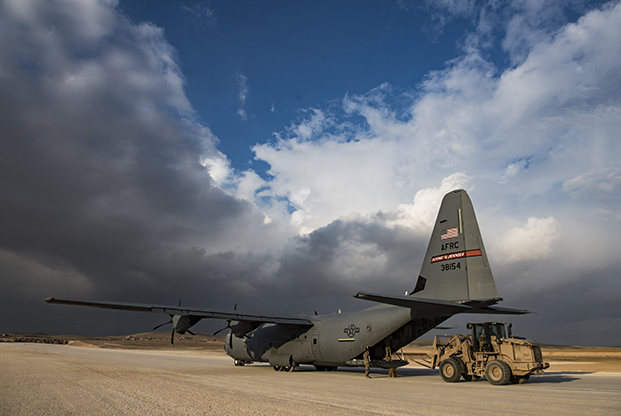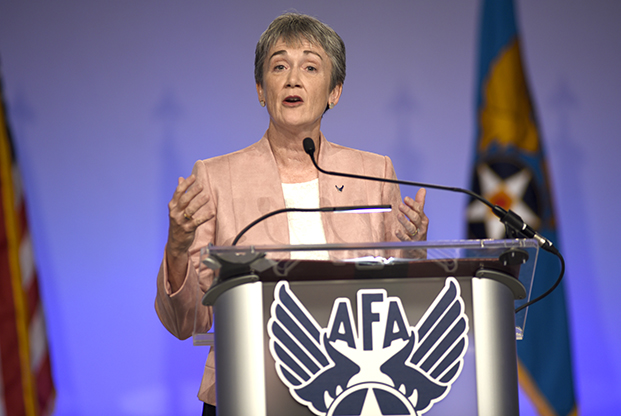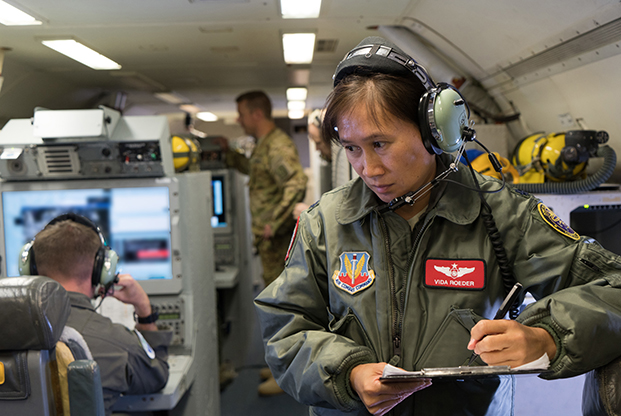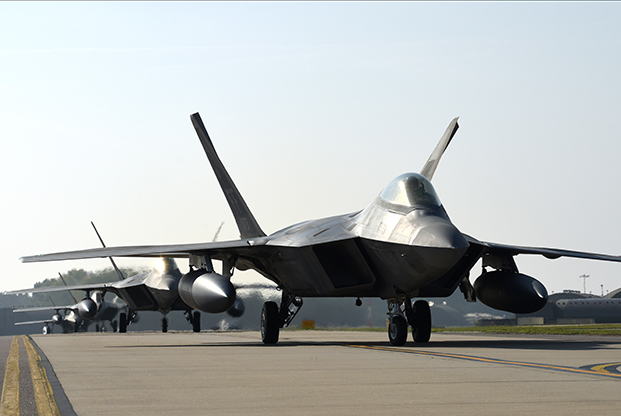
Future conflicts might require many small USAF units to deploy to austere airfields, taking only support equipment and people required to conduct operations. A C-130 from the 746th Expeditionary Airlift Squadron unloads equipment at an undisclosed location in Syria. Photo: TSgt. Gregory Brook
Today’s Air Force may still be the best in the world, but it’s no match for a National Military Strategy that demands more than the current force can deliver.
After years of cutbacks, today’s force is undermanned and under-equipped, Air Force leaders say, and the fight is on to build a bigger, more capable and ready force aligned with the requirements of the National Defense Strategy released in January.
The future force should include 386 squadrons, 74 more than today’s 312, Air Force Secretary Heather Wilson said in defining “the force we need.” That represents a 24 percent increase and would also require tens of thousands more airmen, Wilson said.
Details about the plan remain scant. The Air Force did not define the size or makeup of the squadrons and steered clear of detailing the number of aircraft or people in each. Instead, the baseline number comes from a half-year review of the service’s force structure and will be a jumping-off point for a more detailed debate with the Pentagon, the White House, and Congress over the coming year.
Wilson set a target of 2025-2030 to complete the expansion, which would bring the service to a size not seen since the early 1990s.
“We aren’t naïve about how long it will take us to build the support and the budget required for the force we need. It is a choice,” Wilson said. “But we have an obligation to our countrymen: To tell them, as those before us have done in their time, what should be done, what must be done.”

The proposed increase was based on data derived from analysis, war games, modeling, and simulation. Top officials from the Air Staff and also major commands participated, using modern intelligence about potential adversaries and the most recent concepts of operations to determine the optimum size of the force. The nation will rely on the Air Force to lead future fights, Wilson argued, and at its current size, USAF can’t meet the demands of the nation’s combatant commanders.
“We know now from analysis what everyone in this room knows from experience,” Wilson said. “The Air Force is too small for what the nation expects of us; 312 Operational Squadrons is not enough.”
Wilson said the additional squadrons will include:
- 22 more command and control and intelligence, surveillance, and reconnaissance squadrons
- 14 more aerial refueling squadrons
- 9 more combat search and rescue squadrons
- 7 more fighter squadrons
- 7 more special operations squadrons
- 7 more space squadrons
- 5 more bomber squadrons
- 2 more remotely piloted aircraft squadrons
- 1 more airlift squadron
While the Air Force will modernize its nuclear deterrent and cyber capabilities, Wilson said the service doesn’t need to increase the number of missile or cyber operations squadrons.
Lt. Gen. Brian T. Kelly, deputy chief of staff for personnel, said the service will need some 45,000 more airmen to fill out 74 additional squadrons. Spread out over 12 years, the service would have to grow by 2 percent a year, something the service hasn’t had to do in decades. Indeed, even during the Reagan buildup of the 1980s, the Air Force only grew by about 3 percent—and then soon after began a long decline.

USAF needs 22 more command and control and ISR squadrons, Air Force Secretary Heather Wilson argues. Here, mission crew commander Lt. Col. Vida Roeder of the 461st Air Control Wing monitors operations supporting a multinational exercise near Denmark. Photo: SMSgt. Roger Parsons
‘NOT A BIRTHRIGHT’
New rivals are rising up to challenge the United States, Wilson said, and the Air Force and the nation cannot claim air dominance as a “birthright” for the US. Rather, she added, it is a choice the country needs to make. The nation cannot be “naïve about the existence of evil, and new threats are emerging to which our generation must respond,” she said.
The Air Force did not immediately explain how the larger force would be dividing among Active Duty, Guard and Reserve, nor did it address how the creation of a new space service would affect the plan. Wilson is developing a plan for creating a new Space Force to be included in the 2020 budget request that goes to Congress in February.
The new benchmark is only “the beginning of the discussion” about what it will take to meet the National Defense Strategy requirements, and there will be “five or six more studies due in the next six months” that will flesh out the details, according to Wilson.
Wilson and Chief of Staff Gen. David L. Goldfein also addressed readiness and argued for a higher standard. In addition to growing the size of the Air Force itself, Goldfein said it was time to take a fresh look at the Air & Space Expeditionary Force deployment model, which has been in place since the mid-1990s. “Over time, we have migrated away from expeditionary forces,” Goldfein said in his keynote address.
“We know how to … fight the base and operate under attack,” he said, but the next fight will be against a near-peer competitor and will require airmen to operate with smaller units spread out over a wider area.
There will be few established bases,” and few of the amenities USAF units have become accustomed to having when they deploy, Goldfein said. Squadrons will have to operate independently and have reachback capability for command and control and other support.

USAF needs seven more fighter squadrons, according to leaders’ analysis. F-22s from the 1st Fighter Wing, JB Langley-Eustis, Va., taxi down the runway at RAF Lakenheath, UK. Photo: SSgt. Alex Fox Echols III
Today’s AEF sources airmen from throughout the Air Force and spins up units before each deployment.
But the homeland is no longer a sanctuary and the Air Force now needs to be ready to deploy with little to no warning, said Lt. Gen. Mark D. Kelly, the deputy chief of staff for operations. Kelly said units must be ready and cohesive enough to operate immediately.
“It’s time to return to our expeditionary roots,” Goldfein declared. New units will have “flexibility and scalability” to address whatever demands the regional commander makes, he said.
The Air Force is already taking some heat because the studies and plans that produced the 386 number are not transparent. The supporting information is either secret or otherwise closely held, making it hard to justify to defense appropriators, Brookings Institution expert Michael E. O’Hanlon said.
“I don’t know what scenarios drove the calculations—they’re classified,” O’Hanlon, director of foreign policy research at the Center for 21st Century Security and Intelligence at the think tank.
Speaking at an AFA Mitchell Institute panel on the service’s new force-structure plan, O’Hanlon said, “If I did know, I could not talk about it here, and some of you do know, and you can’t talk about it here with me, which means we can’t talk about it with the broader nation, which means we can’t easily relate it to broader questions of US foreign policy and budget priorities.”
Air Force leaders said the new baseline figures will inform the Fiscal Year 2020 budget deliberations, which were headed into their final stages at the time of the conference.